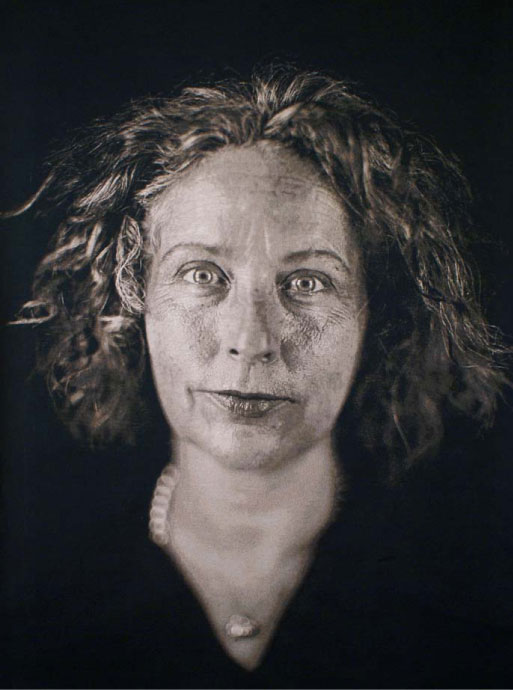
Kiki Smith, 2006, © Chuck Close, courtesy The Pace Gallery
Editor’s Note: This is the seventh installment of an eight-part series from Adam Harrison Levy about designers, artists and cooking. To see all the installments, click here.
Veins and arteries trickle from the wall and pool in concentric circles on the floor: glass beads and wire. A digestive tract is a slithering snake etched onto Japanese paper. Kidneys are two crimson balloons: a potato print with silver-leaf additions. Kiki Smith takes the body and turns it inside out. She makes art from innards.
But she eats salad.
“My assistants and I have lunch everyday. We eat lots of healthy food, like broccoli rabe with lemon zest and olive oil. I like things that are stringent.”
She also likes flavorful contradictions. “My tastes in things are diametrically opposed.” She likes lemon pickle with honey on toast.
Her father, Tony Smith the sculptor, moved out of the family home (where he was born and grew up) when Smith was in the fourth grade. He lived in another house about a mile away. Her mother, Jane Lawrence Smith, who was an opera singer, would wake Kiki and her sisters up in the morning, make them breakfast, take them to school, and then she would go to their father's home and make him breakfast. She would then do all the shopping, pick the girls up from school and take them to their father’s where she made dinner. “My mother cooked proper dinners. We would all sit down together in the dining room. And the plates were heated in the oven. You know, it was a proper dining experience.” Her mother would then bring the children back home, urge them to do their schoolwork, and put them to bed.
“We were a little bit like the Addams Family,” she said once in an interview. In the front yard of their Victorian house there was a gravestone with the name “Smith” on it (stolen from the cemetery by an uncle). Her bedroom was in the wing of an otherwise unoccupied part of the house. She had a real skull in her bedroom on which she once put a photograph of Charles Manson, as a protective totem against death. “In my family there was always a kind of morbidity.”
The local supermarket was a source of furniture as well as food. After her Grandparent’s died, an aunt came to the family home and stripped it bare. When the Smith’s moved in they had nothing. So once a week her father would take the girls to the supermarket, and collect the cardboard boxes that had been left out back. The children would then paint the boxes and he would turn them into furniture — nightstands, bookcases, and bureaus.
Smith went to baking school for vocational training. Baking, she says, “is similar to making art because you are mixing potions that are transformative and sustaining. It's just that baking is more fleeting than making objects.”
Making objects is at the center of her life now. Her art is driven by a fascination with the forms of everyday life — their deep histories as well as the stories that are embedded within them. Interestingly, her domestic arrangements blur the line between life and art. Like her father, her house is also her studio. She has a bevy of assistants who work with her; they lunch together communally everyday. Often they eat salad. “We like almost anything roasted — tomatoes, root vegetables — and we eat lots of shitake mushrooms.” Her recipe is for one of their favorite dishes.
Referring to her art, she once said, “It's always about shifting the possibilities of what can be beautiful.” When it comes to the human body, for example, she finds beauty in organs, bodily liquids and secretions. When it comes to food, aesthetics play an unusually large part of Smith's taste in eating.
When Smith goes to a restaurant instead of asking the waiter which dish on the menu tastes the best she asks which dish looks the most beautiful. The color and arrangement of her food on her plate is as important to her as its taste. “I like dark colors in my salad” she says. “It has to look good.”
Kiki Smith's Salad
INGREDIENTS:
3 medium size sweet potatoes or yams chopped into about 1/2-3/4" pieces, or sliced if preferred
1 large bunch of arugula, washed
1 bunch of cilantro, whole leaves picked from stems, washed
several tablespoons of olive oil
lime
garlic
jalapeno
Maldon salt
ricotta salata
gluten-free crackers
INSTRUCTIONS:
1) Pre-heat oven to 425 degrees.
2) Toss sweet potato with olive oil and, if desired, Maldon salt. Roast sweet potatoes in oven until brown, around 30 minutes (preferably on a Slipat, which makes for easy cleaning).
3) Meanwhile, make a dressing using olive oil, lime juice, chopped garlic and chopped jalapeno (seeded) to taste.
4) Place arugula in a large bowl. Top with potatoes, cilantro and dressing. If desired, top with shaved ricotta salata. Kiki prefers not to mix the salad or to do so at the table. Serve with gluten-free crackers and as many other colored vegetables as possible.
A version of this article originally appeared on Gourmet Live!

